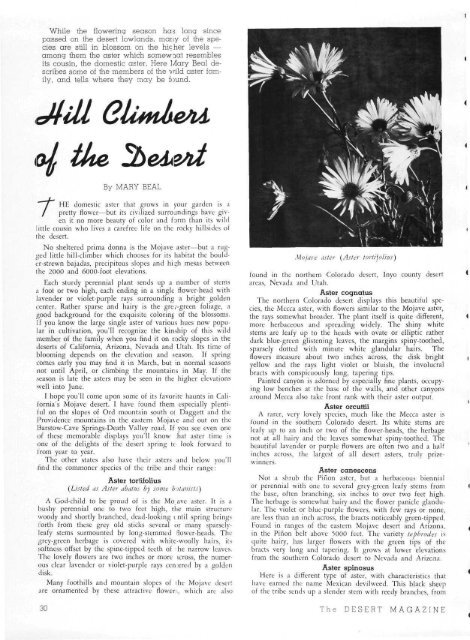the magazine y - Desert Magazine of the Southwest
the magazine y - Desert Magazine of the Southwest
the magazine y - Desert Magazine of the Southwest
Create successful ePaper yourself
Turn your PDF publications into a flip-book with our unique Google optimized e-Paper software.
While <strong>the</strong> flowering season has long since<br />
passed on <strong>the</strong> desert lowlands, many <strong>of</strong> <strong>the</strong> species<br />
are still in blossom on <strong>the</strong> hie her levels -<br />
among <strong>the</strong>m <strong>the</strong> aster which somewnat resembles<br />
its cousin, <strong>the</strong> domestic aster. Here Mary Beal describes<br />
some <strong>of</strong> <strong>the</strong> members <strong>of</strong> <strong>the</strong> wild aster family,<br />
and tells where <strong>the</strong>y may be found.<br />
JHU<br />
By MARY BEAL<br />
rHE domestic aster that grows in your garden is a<br />
pretty flower—but its civilized surrojndings have given<br />
it no more beauty <strong>of</strong> color and fDrm than its wild<br />
little cousin who lives a carefree life on <strong>the</strong> rocky hillsides <strong>of</strong><br />
<strong>the</strong> desert.<br />
No sheltered prima donna is <strong>the</strong> Mojave aster—but a rugged<br />
little hill-climber which chooses for its habitat <strong>the</strong> boulder-strewn<br />
bajadas, precipitous slopes and hijh mesas between<br />
(he 2000 and 6000-foot elevations.<br />
Each sturdy perennial plant sends up a number <strong>of</strong> steins<br />
a foot or two high, each ending in a single flower-head with<br />
lavender or violet-purple rays surrounding a bright golden<br />
center. Ra<strong>the</strong>r sparse and hairy is <strong>the</strong> gre/-green foliage, a<br />
good background for <strong>the</strong> exquisite coloring <strong>of</strong> <strong>the</strong> blossoms.<br />
If you know <strong>the</strong> large single aster <strong>of</strong> various hues now popular<br />
in cultivation, you'll recognize <strong>the</strong> kinship <strong>of</strong> this wild<br />
member <strong>of</strong> <strong>the</strong> family when you find it on rocky slopes in <strong>the</strong><br />
deserts <strong>of</strong> California, Arizona, Nevada and Utah. Its time <strong>of</strong><br />
blooming depends on <strong>the</strong> elevation and season. If spring<br />
comes early you may find it in March, but in normal seasons<br />
not until April, or climbing <strong>the</strong> mountains in May. If <strong>the</strong><br />
season is late <strong>the</strong> asters may be seen in <strong>the</strong> higher elevations<br />
well into June.<br />
I hope you'll come upon some <strong>of</strong> its favorite haunts in California's<br />
Mojave desert. I have x ound <strong>the</strong>m especially plentiful<br />
on <strong>the</strong> slopes <strong>of</strong> Ord mountain south ol Daggett and <strong>the</strong><br />
Providence mountains in <strong>the</strong> eastern Moja\e and out on <strong>the</strong><br />
Barstow-Cave Springs-Death Valley road. If you see even one<br />
<strong>of</strong> <strong>the</strong>se memorable displays you'll know hat aster time is<br />
one <strong>of</strong> <strong>the</strong> delights <strong>of</strong> <strong>the</strong> desert spring tc look forward to<br />
from year to year.<br />
The o<strong>the</strong>r states also have <strong>the</strong>ir asters and below you'll<br />
find <strong>the</strong> commoner species <strong>of</strong> <strong>the</strong> tribe and <strong>the</strong>ir range:<br />
Aster tortifolius<br />
(Listed as Aster abatus by some botanists)<br />
A God-child to be proud <strong>of</strong> is <strong>the</strong> Mo ave aster. It is a<br />
bushy perennial one to two feet high, <strong>the</strong> main structure<br />
woody and shortly branched, dead-looking i ntil spring brings<br />
forth from <strong>the</strong>se grey old sticks several or many sparselyleafy<br />
stems surmounted by long-stemmed flower-heads. The<br />
grey-green herbage is covered with white-woolly hairs, its<br />
s<strong>of</strong>tness <strong>of</strong>fset by <strong>the</strong> spine-tipped teeth <strong>of</strong> he narrow leaves.<br />
The lovely flowers are two inches or more icross, <strong>the</strong> numerous<br />
clear lavender or violet-purple rays cen.ered by a golden<br />
disk.<br />
Many foothills and mountain slopes <strong>of</strong> I he Mojave desert<br />
are ornamented by <strong>the</strong>se attractive flower:,, which art also<br />
Mojave aster (Aster tortifolius)<br />
found in <strong>the</strong> nor<strong>the</strong>rn Colorado desert, Inyo county desert<br />
areas, Nevada and Utah.<br />
Aster cognatus<br />
The nor<strong>the</strong>rn Colorado desert displays this beautiful species,<br />
<strong>the</strong> Mecca aster, with flowers similar to <strong>the</strong> Mojave aster,<br />
<strong>the</strong> rays somewhat broader. The plant itself is quite different,<br />
more herbaceous and spreading widely. The shiny white<br />
stems are leafy up to <strong>the</strong> heads with ovate or elliptic ra<strong>the</strong>r<br />
dark blue-green glistening leaves, <strong>the</strong> margins spiny-too<strong>the</strong>d,<br />
sparsely dotted with minute white glandular hairs. The<br />
flowers measure about two inches across, <strong>the</strong> disk bright<br />
yellow and <strong>the</strong> rays light violet or bluish, <strong>the</strong> involucral<br />
bracts with conspicuously long, tapering tips.<br />
Painted canyon is adorned by especially fine plants, occupying<br />
low benches at <strong>the</strong> base <strong>of</strong> <strong>the</strong> walls, and o<strong>the</strong>r canyons<br />
around Mecca also take front rank with <strong>the</strong>ir aster output.<br />
Aster orcuttii<br />
A rarer, very lovely species, much like <strong>the</strong> Mecca aster is<br />
found in <strong>the</strong> sou<strong>the</strong>rn Colorado desert. Its white stems are<br />
leafy up to an inch or two <strong>of</strong> <strong>the</strong> flower-heads, <strong>the</strong> herbage<br />
not at all hairy and <strong>the</strong> leaves somewhat spiny-too<strong>the</strong>d. The<br />
beautiful lavender or purple flowers are <strong>of</strong>ten two and a half<br />
inches across, <strong>the</strong> largest <strong>of</strong> all desert asters, truly prizewinners.<br />
Aster canescens<br />
Not a shrub <strong>the</strong> Pinon aster, but a herbaceous biennial<br />
or perennial with one to several grey-green leafy stems from<br />
<strong>the</strong> base, <strong>of</strong>ten branching, six inches to over two feet high.<br />
The herbage is somewhat hairy and <strong>the</strong> flower panicle glandular.<br />
The violet or blue-purple flowers, with few rays or none,<br />
are less than an inch across, <strong>the</strong> bracts noticeably green-tipped.<br />
Found in ranges <strong>of</strong> <strong>the</strong> eastern Mojave desert and Arizona,<br />
in <strong>the</strong> Pirion belt above 5000 feet. The variety tephrodes is<br />
quite hairy, has larger flowers with <strong>the</strong> green tips <strong>of</strong> <strong>the</strong><br />
bracts very long and tapering. It grows at lower elevations<br />
from <strong>the</strong> sou<strong>the</strong>rn Colorado desert to Nevada and Arizona.<br />
Aster spinosus<br />
Here is a different type <strong>of</strong> aster, with characteristics that<br />
have earned <strong>the</strong> name Mexican devilweed. This black sheep<br />
<strong>of</strong> <strong>the</strong> tribe sends up a slender stem with reedy branches, from<br />
30 The DESERT M A G A Z I N E

















